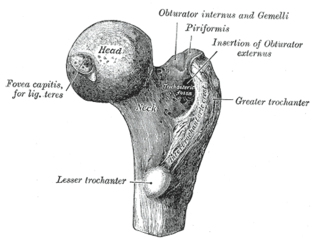This page is based on this
Wikipedia article Text is available under the
CC BY-SA 4.0 license; additional terms may apply.
Images, videos and audio are available under their respective licenses.

The Kentucky and Virginia Resolutions were political statements drafted in 1798 and 1799, in which the Kentucky and Virginia legislatures took the position that the federal Alien and Sedition Acts were unconstitutional. The resolutions argued that the states had the right and the duty to declare as unconstitutional those acts of Congress that were not authorized by the Constitution. In doing so, they argued for states' rights and strict constructionism of the Constitution. The Kentucky and Virginia Resolutions of 1798 were written secretly by Vice President Thomas Jefferson and James Madison respectively.

The greater trochanter of the femur is a large, irregular, quadrilateral eminence and a part of the skeletal system.

Thomas LeRoy Collins was an American attorney and politician, the 33rd Governor of Florida, serving a special term in 1955, and being elected to a four-year term in 1956, serving through 1961. He was previously elected to several terms in the Florida House of Representatives and Senate. He was the first governor of the South to promote the moral necessity of ending segregation. Counseling "progress under law", he took a moderate course during the civil rights movement and is remembered as a voice for civil rights.

Bleach bypass, also known as skip bleach or silver retention, is an optical effect which entails either the partial or complete skipping of the bleaching function during the processing of a color film. By doing this, the silver is retained in the emulsion along with the color dyes. The result is a black-and-white image over a color image. The images usually have reduced saturation and exposure latitude, along with increased contrast and graininess. It usually is used to maximum effect in conjunction with a one-stop underexposure.
Arthroplasty is an orthopedic surgical procedure where the articular surface of a musculoskeletal joint is replaced, remodeled, or realigned by osteotomy or some other procedure. It is an elective procedure that is done to relieve pain and restore function to the joint after damage by arthritis or some other type of trauma.

The cerebellum has four deep cerebellar nuclei embedded in the white matter in its center.
Third Party Non-violent Intervention refers to the practice of intervening from the outside in violent conflicts with the aim of reducing violence and allowing "space" for conflict resolution. Two common forms of intervention are as an intermediary in a negotiating capacity or, physically, by interposing one's body between two factions.
An interpositive, intermediate positive, IP or master positive is an orange-based motion picture film with a positive image made from the edited camera negative. The orange base provides special color characteristics that allow for more accurate color reproduction than if the IP had a clear base, as in print films.
An internegative is a motion picture film duplicate. It is the color counterpart to an interpositive, in which a low-contrast color image is used as the positive between an original camera negative and a duplicate negative.
Thomas Morgan was an English deist.

The emboliform nucleus is a deep cerebellar nucleus that lies immediately to the medial side of the nucleus dentatus, and partly covering its hilum. It is one among the four pairs of deep cerebellar nuclei, which are from lateral to medial: the dentate, interposed, and fastigial nuclei. These nuclei can be seen using Weigert's elastic stain.
Nullification, in United States constitutional history, is a legal theory that a state has the right to nullify, or invalidate, any federal law which that state has deemed unconstitutional with respect to the United States Constitution. The theory of nullification has never been legally upheld by federal courts.
Psalm 17 is the 17th psalm from the Book of Psalms.
Interposing Tactics is tactical concept, developed under Terrorist Tactics, Techniques, and Procedures, to explain a tactical action where a small-scale action takes place between two combatants, where one manoeuvres into interposition or interjection within a tactical situation, and disrupts the action or activity, of the opponent.
A block is a defensive tactic in chess in response to an attack, consisting of interposing a piece between the opponent's attacking piece and the piece being attacked. This type of blocking will only work if the attacking piece is a type that can move linearly an indefinite number of squares such as a queen, rook, or bishop and there is at least one empty square in the line between the attacking and attacked piece. Blocking is not an option when the attacking piece is directly adjacent to the piece it is attacking, or when the attacking piece is a knight. When an opponent's attack on a piece is blocked, the blocking piece is to some extent pinned, either relatively or absolutely, until a future move by either side allows it to be unpinned.
Ileal Interposition is a Metabolic Surgery procedure, used to treat overweight diabetic patients through surgical means. First presented by the Brazilian surgeon Aureo De Paula in 1999, this technique is applied by placing ileum, which is the distal part of the small intestine, either between stomach and the proximal part of the small intestine (1) or by placing the ileum to the proximal part of the small intestine without touching the natural connections of the stomach (2).
There are 2 different versions of the operation. Sleeve gastrectomy procedure is standard for both of the versions.






